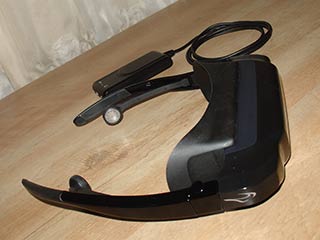 Video glasses are one of those items that are supposed to be relegated to science fiction movies, books or perhaps merely the idle mind. Pity nobody told Vuzix.
Video glasses are one of those items that are supposed to be relegated to science fiction movies, books or perhaps merely the idle mind. Pity nobody told Vuzix.
Read on for our real life review of a pair of AV920 video glasses.
When I told friends that I would be reviewing a pair of cleverly named “iWear” video glasses most scoffed in disbelief. Despite having cleared the millennium by nearly a decade, video glasses are one of those things that just haven’t hit every day reality the same way as say, iPhones have.
VISUALLY SPEAKING
With this in mind, I wasn’t sure what to expect when I opened up the package from Vuzix. Inside I found a small box marked iWear AV920 video eyewear, a Vuzix branded portable DVD player, a few cables and a light shield – a light shield being an attachment that connects to the glasses to block out unwanted light.
The AV920s are packaged with a lens cleaning pouch, headstrap, AC power adapter/charger (US) composite mini (iWear specific) A/V cable, an RCA adapter cable and all the usual manual and warranty cards. The glasses themselves look – for want of a better word – cool. While permanently connected via cable, the unit can best be described as having two distinct parts. The visor section (think glasses) weighs 85g. While this may sound heavy compared to my old Oakley Half Jackets (20g), I can happily report the AV920s feel rather light and comfortable when sitting on your nose.
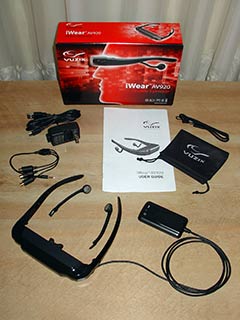 The glasses are finished in two tone black, with the most outwardly visible parts finished in a stylish gloss black. The inner portion surrounding the actual LCDs are a more ordinary matte plastic black. Like many sunglasses, the AV920s temples are tipped with a rubber coating for comfortable fit behind your ears. A similarly rubberised bridge sits the glasses gently on your nose. The glasses are approximately 34mm at their thickest point and while they might look a little out of this world, they don’t protrude out far enough to feel strange or otherwise unbalanced. To the right of the right LCD lies a small dial which is used to power the glasses on/off as well as traverse the simple menu system.
The glasses are finished in two tone black, with the most outwardly visible parts finished in a stylish gloss black. The inner portion surrounding the actual LCDs are a more ordinary matte plastic black. Like many sunglasses, the AV920s temples are tipped with a rubber coating for comfortable fit behind your ears. A similarly rubberised bridge sits the glasses gently on your nose. The glasses are approximately 34mm at their thickest point and while they might look a little out of this world, they don’t protrude out far enough to feel strange or otherwise unbalanced. To the right of the right LCD lies a small dial which is used to power the glasses on/off as well as traverse the simple menu system.
The way the AV920s have been designed allows for both the bridge and temples to be easily moved to create a range of sitting positions. The temples pivot 15 degrees and the hypo-allergenic nosepiece (bridge) offers up to 9.5mm of travel.
 Completing the visor section are two easily removable speakers (earphones) which are flexible and can be bent (to an extent) to your particular head measurements.
Completing the visor section are two easily removable speakers (earphones) which are flexible and can be bent (to an extent) to your particular head measurements.
The other part of the glasses is connected via a permanent 1300mm cable and consists of a small rectangular battery/AV connector pack. This pack weighs only 40g and with dimensions of 40x85x13mm, fits easily in your pocket. It has three connectors – each with its own LED: A vuzix A/V port, Mini USB (for charging and firmware updates) and a dedicated 3.5mm headphone port. We found this pack to be able to power the glasses for approximately five hours on one charge.
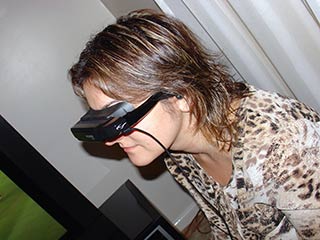 ON YOUR FACE
ON YOUR FACE
I plugged the AV920 into a PC via the USB cable and left it overnight to charge. The next morning we connected up the supplied Vuzix portable DVD player and played the supplied 3D test disc. It is worth noting here that the AV920 is both PAL and NTSC compatible.
The outer packaging claims the AV920s twin 640×480 LCD screens create a virtual 62 inch screen and while measuring such a claim is difficult, the relative closeness of the image when viewed with the glasses certainly does look big. In completely unscientific measurements, the screen size compared favourably to sitting a few metres away from our 50 inch Pioneer plasma reference set.
Using the built in menu, I set the glasses to one of its 3D settings and watched the supplied 3D trailers DVD via a Vuzix portable DVD player. While 3D content did appear mildly 3D I found the actual picture difficult to tune in to and it felt like I was really concentrating hard to see the image. Maybe I was going for too much, too soon: I decided to step down to some more familiar 2D DVD content.
Setting the glasses back to 2D mode, the picture felt more comfortable to my eyes but still didn’t feel quite right. I adjusted the bridge and pivoted the temples briefly but I didn’t find a genuinely comfortable setting. When I say comfortable, I am speaking visually. Physically, the actual glasses felt almost as comfortable as my Oakleys.
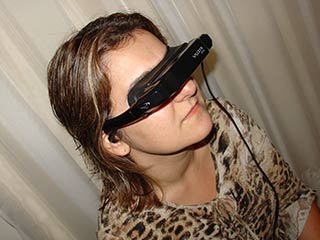 In a bit of random testing I closed one eye and noticed a drastic improvement in clarity – in fact, when viewing the two LCDs individually (closing one eye at a time) I noticed that one was a lot darker and unfocused than the other.
In a bit of random testing I closed one eye and noticed a drastic improvement in clarity – in fact, when viewing the two LCDs individually (closing one eye at a time) I noticed that one was a lot darker and unfocused than the other.
As I thought the unit may be defective, I decided to call Vuzix support. The kind chap on the other end was very helpful and told me about “interpupillary distance” and its relevance to how the Vuzix AV920s worked. The short version is that for effective viewing, your eyes need to be a particular distance apart – roughly matching the distance of the LCDs. Furthermore, Vuzix has designed the AV920s to cater for approximately 90% of the American adult population and the diagnosis was that it would appear I fell outside this range.
Luckily, short of some pretty radical surgery, Vuzix support offered a few more plausible options like trying once more to again adjust the angle at which the LCDs pointed towards my eyes by pivoting the temples in conjunction with placing the bridge in upside down. It was also intimated that a firmware update would likely be released to allow for adjustment of the left and right LCDs independently.
I sat back down and had a more determined go at adjusting the glasses to fit my particular head. After some trial and error I did manage to find a position that felt much better than before but in all honesty, I was never completely comfortable – again, from a visual sense. With these new settings I watched some more videos and after a while got relatively used to the view. I can’t say I was ever completely at ease but at the very least, I concentrating less on seeing and more on the actual videos. Unfortunately, as I relaxed, I became increasingly aware of the actual image quality.
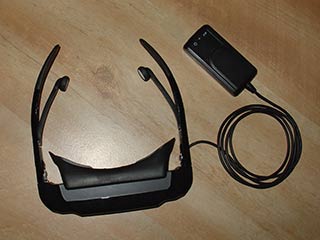 With one eye closed, the image was relatively crisp but plagued by a continuously rolling background noise. While Vuzix has higher quality connectors available (S-Video connectors are an option) the highest quality adapters provided for review was a composite RCA cable.
With one eye closed, the image was relatively crisp but plagued by a continuously rolling background noise. While Vuzix has higher quality connectors available (S-Video connectors are an option) the highest quality adapters provided for review was a composite RCA cable.
To try and improve image quality we connected up our XBOX 360 for some RCA gaming action. While I was pleased that the rolling noise was completely eradicated using this connection – suggesting the cable/portable DVD player was to blame – the actual XBOX 360 dash was displayed incorrectly. Part of the top of the image was doubled at the bottom of the screen as if caused by a mismatch of widescreen and full screen settings. We changed our XBOX 360 settings to try and fix this issue but after a number of attempts, found no way to get a correct image.
Despite this, we threw on some games which evidenced some LCD blurring but otherwise worked okay. I say okay because running the usual 1080p goodness into the Vuzix glasses really put them in their place. Playing Rez HD, for example looked very much like the low resolution Dreamcast version of yesteryear which really polarized my opinion of the iWear AV920s. The glasses are futuristic in their design and concept, but the image quality is akin to older standard definition content. While this is mostly due to the technological limitations of packing so much into so little a space, it is still a concern to those currently enjoying High Definition content.
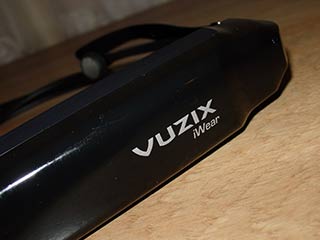 The audio from the included “removable flexible speakers” on the other hand was generally quite good. The flexing of the speakers was a little haphazard and they would not stretch to fit my ear but this proved to be of no consequence. The clarity and loudness was such, that placing these speakers just beneath my ear hole provided an acceptable and really quite comfortable experience. In any case, the unit’s AV/power pack can also accommodate any regular 3.5mm headphones.
The audio from the included “removable flexible speakers” on the other hand was generally quite good. The flexing of the speakers was a little haphazard and they would not stretch to fit my ear but this proved to be of no consequence. The clarity and loudness was such, that placing these speakers just beneath my ear hole provided an acceptable and really quite comfortable experience. In any case, the unit’s AV/power pack can also accommodate any regular 3.5mm headphones.
FEATURES AND SPECIFICATIONS
Supported Devices Include:
- Portable DVD players
- Media players
- Gaming systems
- Digital cameras
- Camcorders
- Cellular phones with video output
- iPod Gen 5 cable included and Gen 6/Touch/iPhone cable available soon
Features:
- iWear® 3D enabled for automatic 2D/3D control; no buttons required
- Can be worn with or without prescription eyeglasses
- The integrated rechargeable lithium ion battery gives approximately five hours of continuous viewing
- Includes mini USB charger
User Adjustable:
- Removable, integrated speakers (no clumsy uncomfortable earbuds) can be upgraded or removed to allow the user to plug in their own headsets
- AccuTilt® viewer pivots up to 15 degrees for comfortable viewing angle
- Soft, comfortable, hypo-allergenic nosepiece extends up to 3/8″
- Custom fit headstrap
Advanced Optics:
- 32-degree field of view
- 3/4″ eye relief and 5/16″ eyebox.
- 2.5″ intraocular distance (IOD).
- Color corrected 10th order aspherical lens with diffractive surface
Technical Specifications:
- Twin high-resolution 640×480 (920,000 pixels) LCD displays
- Equivalent to a 62″ screen viewed from 9 feet
- Millions of colors
- Visor weighs 2.9 ounces
- Integrated rechargeable lithium ion battery allows approximately five hours of continuous operation
- 60 Hz progressive scan update rate
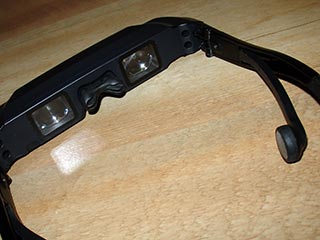 CONCLUSION
CONCLUSION
Despite playing with the contrast and brightness settings, in all our tests, the image quality remained decidedly average. The blacks were greyish and the overall image quality was quite poor. While some of this was partly due to my interpupillary distance – watching the image with one eye drastically improved quality for me – I would compare the overall image quality to that of a budget big screen LCD. How this compares with other portable LCDs is something more useful and in my limited experience with such devices I would say the AV920 is par for the course, albeit with a pretty unique “cool” factor.
While my personal experience wasn’t stellar – most probably due to my inherent incompatibility with the AV920 glasses, others who tried the glasses were far more positive. My partner, for one, found the image quite easy to watch and had none of my “interpupillary distance” issues.
For peace of mind Vuzix have a 30 day money back guarantee which allows those interested in this technology to really find out if they are compatible with it – risk free. The reality is that much like a pair of sunglasses, you really won’t know how comfortable you will be with these (or I suspect any type of video glasses) until you have sat down with them and experienced them first hand.
The iWear AV920 Video Eyewear is available from the Vuzix website for $349.95US


